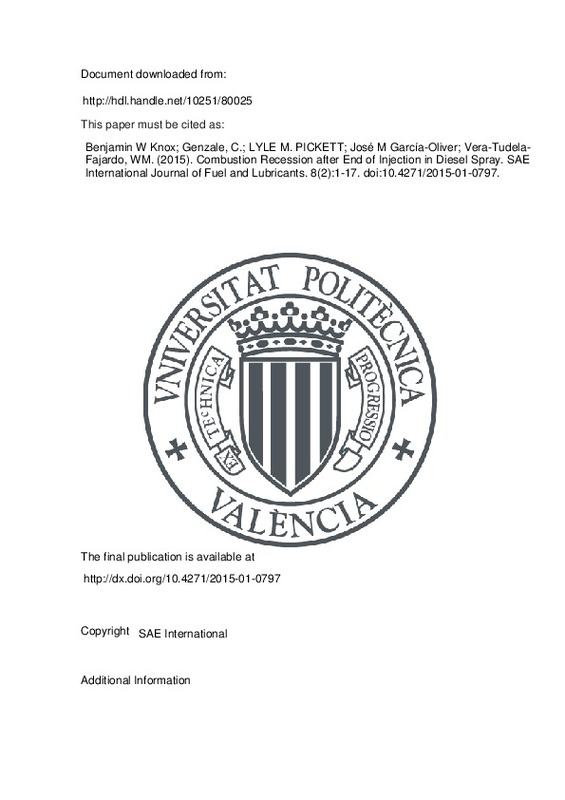JavaScript is disabled for your browser. Some features of this site may not work without it.
Buscar en RiuNet
Listar
Mi cuenta
Estadísticas
Ayuda RiuNet
Admin. UPV
Combustion Recession after End of Injection in Diesel Spray
Mostrar el registro sencillo del ítem
Ficheros en el ítem
| dc.contributor.author | Knox, Benjamin W
|
es_ES |
| dc.contributor.author | Genzale, Caroline
|
es_ES |
| dc.contributor.author | Pickett, L.
|
es_ES |
| dc.contributor.author | García-Oliver, José M.
|
es_ES |
| dc.contributor.author | Vera-Tudela, Walter Martin
|
es_ES |
| dc.date.accessioned | 2017-04-26T11:15:37Z | |
| dc.date.available | 2017-04-26T11:15:37Z | |
| dc.date.issued | 2015-04 | |
| dc.identifier.issn | 1946-3952 | |
| dc.identifier.uri | http://hdl.handle.net/10251/80025 | |
| dc.description.abstract | This work contributes to the understanding of physical mechanisms that control flashback, or more appropriately combustion recession, in diesel-like sprays. Combustion recession is the process whereby a lifted flame retreats back towards the injector after end-of-injection under conditions that favor autoignition. The motivation for this study is that failure of combustion recession can result in unburned hydrocarbon emissions. A large dataset, comprising many fuels, injection pressures, ambient temperatures, ambient oxygen concentrations, ambient densities, and nozzle diameters is used to explore experimental trends for the behavior of combustion recession. Then, a reduced-order model, capable of modeling non-reacting and reacting conditions, is used to help interpret the experimental trends. Finally, the reduced-order model is used to predict how a controlled ramp-down rate-ofinjection can enhance the likelihood of combustion recession for conditions that would not normally exhibit combustion recession. In general, fuel, ambient conditions, and the spray rate-of-injection transient during the end-of-injection determine the success or failure of combustion recession. The likelihood of combustion recession increases for higher ambient temperatures and oxygen concentrations as well as for higher reactivity fuels. In the transition between high and low ambient temperature (or oxygen concentration), the behavior of combustion recession changes from spatially sequential ignition to separated, or isolated, ignition sites that eventually merge. In contradistinction to typical diesel ignition delay trends where the autoignition times are longer for increasing injection pressure, the time required for combustion recession increases with injection pressure. | es_ES |
| dc.language | Inglés | es_ES |
| dc.publisher | SAE International | es_ES |
| dc.relation.ispartof | SAE International Journal of Fuel and Lubricants | es_ES |
| dc.rights | Reserva de todos los derechos | es_ES |
| dc.subject.classification | MAQUINAS Y MOTORES TERMICOS | es_ES |
| dc.title | Combustion Recession after End of Injection in Diesel Spray | es_ES |
| dc.type | Artículo | es_ES |
| dc.identifier.doi | 10.4271/2015-01-0797 | |
| dc.rights.accessRights | Abierto | es_ES |
| dc.contributor.affiliation | Universitat Politècnica de València. Escuela Técnica Superior de Ingeniería del Diseño - Escola Tècnica Superior d'Enginyeria del Disseny | es_ES |
| dc.description.bibliographicCitation | Knox, BW.; Genzale, C.; Pickett, L.; García-Oliver, JM.; Vera-Tudela, WM. (2015). Combustion Recession after End of Injection in Diesel Spray. SAE International Journal of Fuel and Lubricants. 8(2):1-17. doi:10.4271/2015-01-0797 | es_ES |
| dc.description.accrualMethod | S | es_ES |
| dc.relation.publisherversion | http://dx.doi.org/10.4271/2015-01-0797 | es_ES |
| dc.description.upvformatpinicio | 1 | es_ES |
| dc.description.upvformatpfin | 17 | es_ES |
| dc.type.version | info:eu-repo/semantics/publishedVersion | es_ES |
| dc.description.volume | 8 | es_ES |
| dc.description.issue | 2 | es_ES |
| dc.relation.senia | 304698 | es_ES |







![[Cerrado]](/themes/UPV/images/candado.png)

